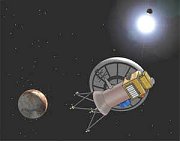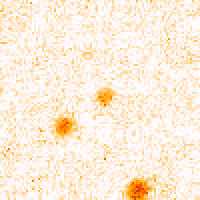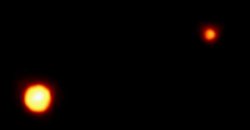 Space Science News home |
|
|
One of these things is not like the othersBut is Pluto really a planet? That's what astronomers have been discussing since late last year when some members of the International Astronomical Union suggested that Pluto be given a minor planet designation. Why? For one thing Pluto is very small. It's 6 times smaller than Earth, and even smaller than seven of the solar system's moons (the Moon, Io, Europa, Ganymede, Callisto, Titan and Triton). Pluto's own moon, Charon, is larger in proportion to its planet than any other satellite in the solar system. Some astronomers consider the pair to be a double planet. |
|
Pluto's elliptical orbit is also unusual. It is the only planetary
orbit which crosses that of another planet (Neptune), and it
is tilted 17 degress with respect to the plane of the solar system.
Astronomers once thought that Pluto may have been a satellite
of Neptune's that was ejected to follow a tilted elliptical path
around the sun. However, careful simulations of the orbits and
dynamics of Pluto and Neptune indicate that this is an unlikely
scenario. Pluto's composition is unknown, but its density (about 2 gm/cm3) indicates that it is probably a mixture of rock and ice. All the other rocky planets -- Mercury, Venus, Earth and Mars -- are located in the inner solar system, close to the Sun. Except for Pluto, all of the outer planets -- Jupiter, Saturn, Uranus and Neptune -- are gaseous giants. Once again, Pluto is a misfit. |
Pluto behind the 8 ballDespite its well-known peculiarities, Pluto's official status
as a planet was never in jeopardy until 1992 when David Jewitt
and J. Luu discovered a curious object called 1992 QB1. QB1 is
a small icy body, similar in size to an asteroid, orbiting 1.5
times further from the sun than Neptune. QB1 was the first hint
that there might be more than just Pluto in the distant reaches
of the solar system. |
|
So, is Pluto really a planet or is it more like a dormant comet,
simply the largest known member of the Kuiper Belt? That's the
question that astronomers have recently been debating. Other than its relatively large size, Pluto is practically indistinguishable from the Kuiper Belt objects (KBOs) and short period comets. The main difference is Pluto's reflectivity, which is much higher than that of known KBOs. |
|
"Pluto has a higher albedo (60%) than we suspect for the
other KBOs," explains Dr. David Jewitt of the University
of Hawaii. "But this is an artifact of size - Pluto has
enough mass & gravity to retain a tenuous atmosphere from which
bright surface frosts may be deposited on the surface."
David Jewitt and his colleagues at the Institute for Astronomy are leaders in the search for new members of the Kuiper Belt. They are presently scanning a 50 sq. degree area of the sky for KBO's using the University of Hawaii's 8192 x 8192 pixel CCD camera, and are experimenting with an even larger 12,000 x 8,000 pixel camera for faster searches. So far their efforts have met with considerable success. They have discovered over 40 KBO's in recent years, some of which are comparable in size to Pluto. "We've already found objects 1/3rd the diameter of Pluto," says David Jewitt," even though we have examined only a tiny fraction of the sky. An example is 1996 TO66, which is 800 km diameter. It would be incredible in its own right if Pluto proved to be the only 2000 km object. I think we'll have Pluto II, Pluto III....within a few years."  Right: Artist's conception of the
Pluto-Kuiper
Express, a spacecraft that NASA planners hope will visit
Pluto and Charon around 2010. Pluto is the only planet in our
Solar System not yet viewed close-up by spacecraft. As a result
many basic questions about Pluto remain unanswered. For example,
what are the mysterious dark patches revealed in Hubble images
of Pluto? Could they be due to photochemical reactions caused
by cosmic rays, or perhaps areas of primordial organic matter?
Does Charon, like Pluto, have dark spots and an atmosphere? Or
is it a very different kind of body? Mission planners hope to
answer these questions and many more. Depending on the success
of the Pluto-Charon encounter, the space probe could go on to
visit objects in the Kuiper Belt. Right: Artist's conception of the
Pluto-Kuiper
Express, a spacecraft that NASA planners hope will visit
Pluto and Charon around 2010. Pluto is the only planet in our
Solar System not yet viewed close-up by spacecraft. As a result
many basic questions about Pluto remain unanswered. For example,
what are the mysterious dark patches revealed in Hubble images
of Pluto? Could they be due to photochemical reactions caused
by cosmic rays, or perhaps areas of primordial organic matter?
Does Charon, like Pluto, have dark spots and an atmosphere? Or
is it a very different kind of body? Mission planners hope to
answer these questions and many more. Depending on the success
of the Pluto-Charon encounter, the space probe could go on to
visit objects in the Kuiper Belt. |

 Right: Kuiper Belt object 1995 WY2
observed UT 1995 Nov 18 using the Keck 10 meter telescope by
D. Jewitt (University of Hawaii) and J. Luu (University of California,
Berkeley). These are the discovery images. Each is a 900 second
integration. The images are separated by about 18 minutes, during
which time the object moves 1 arcsecond. Stationary background
galaxies are also evident in this short movie. The apparent magnitude
is V = 24.2. For more information see David Jewitt's
Right: Kuiper Belt object 1995 WY2
observed UT 1995 Nov 18 using the Keck 10 meter telescope by
D. Jewitt (University of Hawaii) and J. Luu (University of California,
Berkeley). These are the discovery images. Each is a 900 second
integration. The images are separated by about 18 minutes, during
which time the object moves 1 arcsecond. Stationary background
galaxies are also evident in this short movie. The apparent magnitude
is V = 24.2. For more information see David Jewitt's 

 Headlines
Headlines